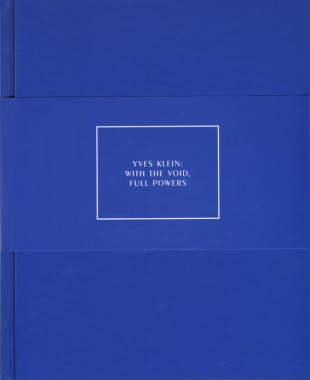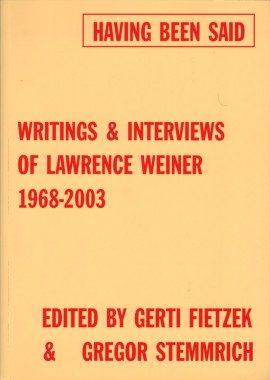Yves Klein: With The Void, Full Powers
Kerry Brougher and Philippe Vergne, Yves Klein: With The Void, Full Powers
Hardcover, 352 pp., offset 4/4, 8 x 10 inches
Edition of 5000
ISBN 978-0-935640-94-6
Published by Walker Art Center
$65.00 ·
Yves Klein: With the Void, Full Powers is published to accompany the first major retrospective of the artist’s work in the United States in nearly 30 years. It includes examples from all of Klein’s major series, including his Anthropometries, Cosmogonies, fire paintings, planetary reliefs and blue monochromes, as well as selections of his lesser-known gold and pink monochromes, body and sponge reliefs, “air architecture” and immaterial works. Essays by curators Kerry Brougher and Philippe Vergne, Klein scholar Klaus Ottmann, art historian Kaira M. Cabañas and curatorial fellow Andria Hickey, as well as archival materials and translations of Klein’s published and unpublished writings, offer insights into the artist’s endeavors and process. Born in Nice, France, in 1928, Yves Klein created what he considered his first artwork when he signed the sky above Nice in 1947, making his earliest attempt to capture the immaterial. The artist carved out new aesthetic and theoretical territory based on his study of the mystical sect Rosicrucianism, philosophical and poetic investigations of space and science, and the practice of Judo, which he described as “the discovery of the human body in a spiritual space.”
Having Been Said: Writings & Interviews Of Lawrence Weiner 1968-2003
Lawrence Weiner, Having Been Said: Writings & Interviews Of Lawrence Weiner 1968-2003
Softcover, 488 pp., offset 1/1, 170 x 240 mm
Edition of 2000
ISBN 9783775791946
Published by Hatje Cantz
out of print
Lawrence Weiner’s art uses language in reference to materials. Language itself is a material and at the same time a means of presentation of his work. Weiner evolved this approach in the context of the Conceptual art of the late 60s, yet he does not see his own work as “conceptual.” The “space” he works within is the entire cultural context, and his works are associated with various different media and forms of presentation: books, posters, videos, films, records, drawings, multiples, installations indoors and outdoors, and more. Since his earliest days as a professional artist, Weiner has given written and verbal expression to questions concerning his work and its context. These utterances — statements, interviews, lectures and conference contributions — have been collected together in this publication for the first time, and ordered chronologically. Taken as a whole they afford an insight both into a complex individual biography and into the wider development of art and culture and the challenge that this entails.

